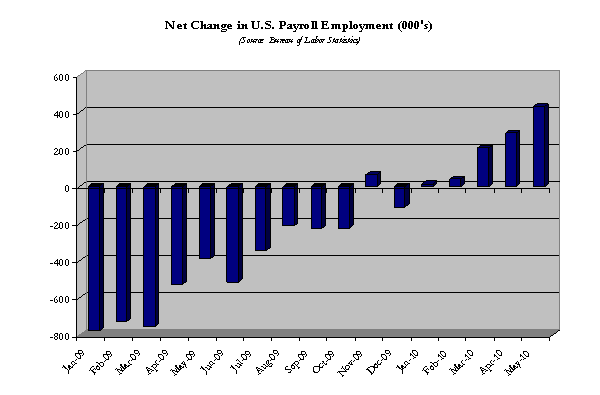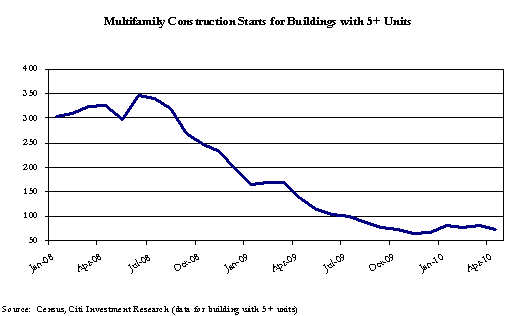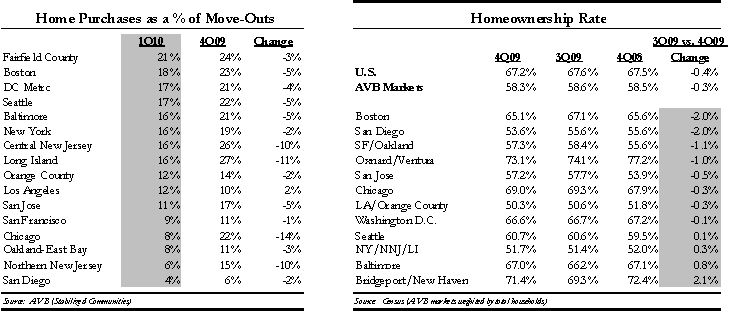EX-99.1
Published on June 9, 2010
Exhibit 99.1
economic recovery
The following Market Research Brief from AvalonBay Communities, Inc. provides our current overview of economic and apartment conditions in our markets. Data is drawn from outside reports and our own portfolio. Please review further details at the end of this Brief.
Summary
Data from both AVBs portfolio and third party reports show that sequential quarter rental revenue growth began turning positive in several AVB markets during 1Q10, a time of normally slower leasing activity. While the economic data suggest that there is now a recovery underway that is likely to include a return to sustainable job growth earlier in 2010 than we previously expected, modest levels of job growth so far do not fully explain the level or timing of improving revenue that the Company is seeing. We believe that other factors such as increased consumer confidence, the unbundling of larger households and the continued decline in homeownership rates are likely explanations.
The Job Market: Current Conditions and Outlook
Nationwide. An economic recovery now appears to be underway, driven in part by improving corporate profits, higher stock prices and a stabilized job market. Though not official, the inflection point of the recovery probably began in June 2009, as evidenced by two quarters of positive GDP growth during the second half of 2009, including very strong Q4 2009 growth of 5.6%. The job market stabilized roughly six months later, as evidenced by essentially flat job growth on average from November 2009 thru February 2010. March 2010 witnessed the return of modest job gains, with an increase in payroll employment of 208,000, followed by another 290,000 jobs in April and 431,000 in May. For the first five months of 2010, job growth averaged just below 200,000 per month.
The current pace of job gains remains modest but is ahead of assumptions used in the outlook we issued at the beginning of this year. Using the May 2010 baseline forecast from Moodys Economy.com, 2010 U.S. job growth is now forecast to average about 100,000 per month (1.2 million jobs for the year), compared to the 35,000 monthly average forecast (400,000 jobs for the year) at the beginning of the year. According to Moodys Economy.com, the improvement is being driven by better and broader than expected growth in manufacturing and consumer spending during Q1 2010, both of which now appear to be supporting sustainable demand as opposed to inventory replacement/pent-up demand. Better than expected growth is also underway in other economies around the globe, which may boost U.S. exports, assuming the European debt situation does not result in reduced demand for U.S. goods and services. The International Monetary Fund recently raised its outlook for 2010 global GDP growth to 4%.
· From a long-term perspective, monthly job gains in payroll employment over the last 20 years have averaged about 100,000 nationwide.
|
AVB Economic & Market Analysis |
June 2010 |

· Compared to prior recoveries, current job market conditions remain below-average according to a recent analysis by Wells Fargo Securities. A major cause for this difference appears to be the replacement of domestically-produced goods with imports, which offsets the increase in domestic production (and increased domestic hiring) generated during earlier recoveries. The record number of long-term unemployed underscores this problem: 44% of unemployed workers have been out of work more than six months.
· Several forecasts we have analyzed continue to call for much stronger job growth after 2010, averaging 200,000 to 250,000 per month in 2011 and 350,000 to 400,000 per month in 2012.
AVB Markets. The governments annual benchmarking revisions to its employment statistics now show that job losses were greater over the last two years than earlier estimates had suggested. Shown below are year/year changes in employment for the U.S. and AVB markets, along with the percentage change decline in total employment since the official beginning of the recent recession in December 2007 (May employment data for AVB markets is not available). The revisions now show that job losses over the last 12 months have been greater in AVB markets relative to the nationwide trend. In both periods, the most severe job losses have been on the West Coast, as shown below.

Our current job growth assumptions for the U.S. and AVB markets are shown below.

Employment trends will likely be noisy during 2010 as a result of the increase in Census workers during Q2 2010 followed by a decrease in Q3 2010. Although the likelihood of a double-dip recession appears to have diminished, economic uncertainty in Europe and sovereign debt concerns could slow economic growth. The $1 trillion European Liquidity program and correlated support with the US Federal Reserve appears to be a strong indication of the resolve that the central banks have toward ensuring stable financial markets.
Apartment Market Conditions
Data from both AVBs portfolio and several third party reports confirm that rental revenue improved during the winter leasing months despite both little evidence of significant hiring and the strong historic correlation between job growth and rental revenue. According to a recent report from REIS, sequential quarter changes were positive in a majority of US and AVB markets during 1Q10 although year over year rent revenue continued to decline. A recent report from Green Street Advisors offered a few explanations for the recent trend: a rebound from excessive discounting used by operators early last year in response to massive job cuts; an increase in the number of household formations, resulting from a stabilizing job market and improved consumer confidence; and sluggish demand for home-buying despite improved home affordability.
· Although real time data on household formations is limited, a recent report from Bank of America noted that Apartments.com (an on-line apartment search site) reported visits to its website were up 11% during 1Q10. Further, site visits in March were reported to be the highest in Apartments.coms 12-year history at 5.1 million.
· The nationwide homeownership rate dropped to 67.2% as of 4Q09. The estimated homeownership rate for AVB markets also fell to 58.3%. Sequential quarter changes are volatile, but a look across markets suggests that Boston and most West Coast markets continued to experience declining homeownership in recent quarters (see Appendix below). Expectations for an increase in foreclosures this year will likely continue pushing homeownership rates lower. We expect that any increase in foreclosures would be unlikely to boost apartment demand significantly, since homeowners driven into the rental market as a result of foreclosure are likely to rent single-family homes.
· Consumer confidence has rebounded to its highest level since March 2008. Although assessments of current conditions remain at low levels (as evidenced by the recent slowdown in consumer spending), assessments of future labor market conditions have returned to normal levels, with the largest improvement among younger age cohorts.
· We believe that there may be more job growth than the official estimates currently suggest. Employment data from the Household Survey has been showing consistent job growth nationwide since December 2009. A smaller and more volatile survey compared to the widely-watched payroll employment data, economists look to the Household Survey as a more accurate gauge of inflection points in economic growth. This suggests that job growth has probably contributed to increased renter demand over the last several months.
Data from AVBs portfolio supports the general trends discussed above:
· Turnover for AVBs same store consolidated portfolio was 42% (annualized) during 1Q10, down from the prior year level of 47%.
· Availability (vacant units plus leases maturing in the next 30 days) averaged 5.6% during 1Q10, the lowest level since 1Q08.
· Economic occupancy rose steadily above the benchmark 96.0% throughout 1Q10 and is the highest since 2Q08.
· Concessions per move-in were flat or lower from 4Q09 in every market except Orange County.
· Move-outs for a home purchase decreased to 14% of total move-outs in 1Q10 (down from 18% during 4Q09), returning to year-ago levels. Declines were greatest in relatively affordable markets (Chicago, suburban New York). The decrease in homebuyers was probably driven by a combination of a harsh winter as well as the initial November deadline for the first-time homebuyer tax credit.
· Changes in move-in and renewal rent have been improving steadily since 4Q09; the renewal rent change turned positive across the AVB portfolio in February and continued in March, driven by increases in the Mid-Atlantic and Boston.
Apartment Supply
The level of multifamily construction starts nationwide (for buildings with 5+ units, both rental and for-sale) has stabilized in recent months at an annualized rate of about 100,000 units as shown below. Assuming an 18-24 month construction period and about 100,000 units lost to obsolescence and/or demolition annually, completions in 2011 would net to zero, suggesting a shortage in rental housing by 2012 if current trends continue.

Highlights by Industry and Region
The following is a look at trends in industries driving local economies in major AVB markets:
Financial Services. Better than expected earnings among Wall Street firms are being reflected in employment data. Employment in the financial services sector stabilized in late 2009 (ahead of forecasts) and is now expected to begin increasing in the second half of 2010, according to a recent analysis by Moodys Economy.com. The impact of bonus payments on the overall local economies may be less than in prior years given that a larger share of bonuses are being paid in stock as opposed to cash. Uncertainty associated with new financial regulation is also a downside risk.
Seven AVB markets have a higher share of financial sector jobs than the U.S. overall (Boston, Fairfield, New York, Northern NJ, Chicago, San Francisco and Orange County). Based on preliminary data, New Yorks sequential monthly employment has been positive in 2010. Third party reports suggest concessions are being reduced or eliminated at prime location rental properties, and leasing driven by job relocations is active.
Technology. Pent-up demand for tech equipment is expected to be strong coming out of this recession, as business spending was relatively soft even during the last expansion. As a result, strong and steady growth in technology jobs is expected over the next several years (per Moodys Economy.com). Because tech industries pay relatively high wages, gains in technology employment will boost average incomes in metropolitan areas with an above-average share of tech jobs, benefiting the entire local economy.
· Hiring is reportedly strong among Internet companies. In San Jose, Google, Facebook and Apple are reportedly hiring and corporate housing activity is increasing.
· Other tech sectors expected to generate job growth include cyber security (DC Metro), biotechnology (San Diego, Northern California, Boston) and software (Seattle, Northern California).
· Nine AVB markets have a higher share of information technology jobs than the U.S. overall. In addition to the markets noted above, these markets are New York, Central NJ and Los Angeles.
Education and Health Services. This employment sector held up well during the recession. While growth in education jobs may be limited going forward given tighter government budgets, an aging population and impacts from new healthcare legislation will likely contribute to continuing growth in employment levels. Interestingly, education and health services account for a larger share of employment relative to the national average in most East Coast AVB markets (except DC Metro) but account for a smaller level of employment in most West Coast markets. This may help explain why the Northeast has held up relatively better during the recent downturn.
Appendix: Home Purchase Move-outs and Homeownership Rates in AVB Markets

This Market Research Brief is being provided to our investors in connection with our presentation at the NAREIT Institutional Investor Forum in Chicago on June 9, 2010, beginning at 2:15 p.m. Details on how to access a webcast of the presentation is available at the Companys website at http://www.avalonbay.com/events. At the presentation, we will discuss the Companys business and our view of the economy and apartment fundamentals, and we will answer questions regarding these and
other matters. We undertake no duty to update this Economic Research Brief, and the views we express herein could change at any time as a result of unforeseen changes in economic data, political or economic developments, or changes in our own portfolio metrics. This Brief should not be understood to provide or imply any specific financial results or forecast for the Company. Any projections or forward-looking statements about the national economy, our markets or apartment fundamentals may prove to be untrue if trends such as employment, GDP, industrial or market growth prove different than discussed herein.
Note: The formatted version of the Economic Research Brief includes three call-out boxes containing the following sentences: The pace of economic recovery is ahead of expectations. Our data and third-party reports confirm rental revenue improvement. Construction trends suggest an impending shortage of rental housing. Nine AVB markets have an above average share of high-tech jobs.
The Economic Research Brief is being distributed with materials including the following graph and text:

We saw the transition in our own portfolio during Q1 2010: economic occupancy averaged 96.2%, the average change in renewal rent turned positive in February, and we now expect sequential quarter rent revenue growth will be positive in Q2 2010.